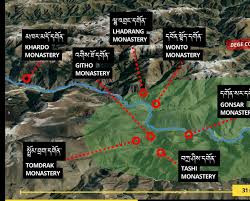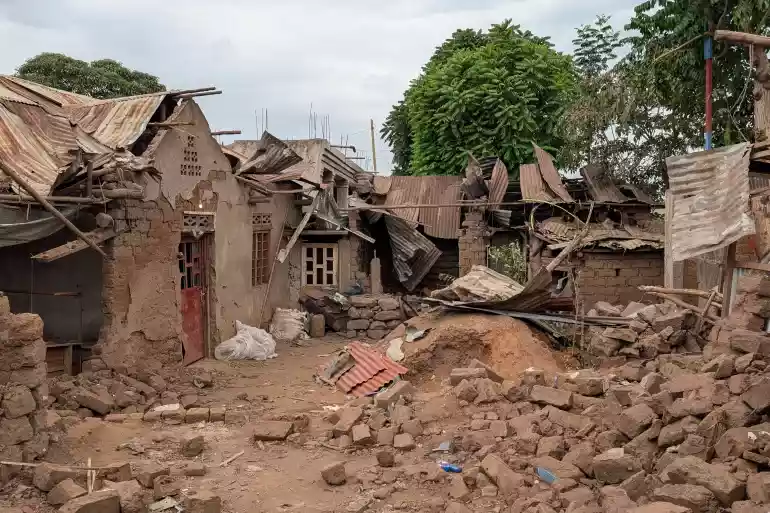
On February 14, hundreds of Tibetans protested the construction of the Kamtok dam, a 1.1 million kilowatt hydropower station on the Drichu River. Protesters demanded a halt to the project and the withdrawal of relocation orders for thousands from Upper Wonto and Shipa villages in Tibet.
These orders affected six major monasteries. Among them is the 13th-century Wonto Monastery, home to priceless murals. Sites will face submersion upon completion of the dam's reservoir. Furthermore, the dam will transmit power only to Chinese cities via the "West to East" network.
Local Tibetans argue that the project disregards the sacred nature of these sites, integral to Tibetan culture and religion. Nonviolent protests ensued but were met with a government crackdown. This resulted in the arrest of over 1,000 Tibetans, including monks. Despite some releases, strict orders restrain further protests, and detainees reportedly endure beatings in custody.
Dr Tsewang Gyalpo Arya is the Representative of the Liaison Office of His Holiness the Dalai Lama for Japan and East Asia (Tibet House). In an interview with JAPAN Forward, he highlights the looming threat of hydropower projects.
These projects not only endanger ancient monasteries but also disrupt the traditional way of life of local communities. Arya emphasizes the broader implications of China's actions, which extend beyond Tibet and affect the entire Asian continent.
The interview explores environmental, cultural, and geopolitical aspects. Dr Arya stresses the urgent need for international attention to address Tibetan concerns.
Excerpts follow.
Could you describe the historical and cultural significance of the Derge region?
- Raza opens up on career threatening cancer scare
- Chevrons to maintain fearless approach against India
- Chevrons seek to break jinx
- Cricket hero Raza draws inspiration from fighter-pilot background
Keep Reading
Tibet comprises Utsang, Kham, and Amdo. In 1965, China redefined these borders, integrating Kham and Amdo into its provinces and creating a Tibet Autonomous Region.
Kham and Amdo became parts of Qinghai and Sichuan Provinces, obscuring Tibet's true identity globally. China's incorporation of these regions into Sichuan was a bid to erase "Tibet" from international discourse. In international forums, China attempts to portray Tibet solely as the Tibet Autonomous Region, which includes only the western and central territories.
Derge lies within the Kham region. It is a traditional Tibetan area known for producing many Tibetan heroes who resisted Chinese occupation.
China is now constructing numerous dams in Tibet to control the region's rivers. As the source of ten major rivers flowing into countries like India, Tibet is often referred to as the "water tower of Asia." These rivers also flow through the Mekong River, reaching China, Cambodia, Laos, and Vietnam.
Police arresting protesting monks in Derge, Tibet (Courtesy of the Liaison Office of His Holiness the Dalai Lama for Japan & East Asia) (Tibet House).
What specific sites are threatened by the hydropower project, including the Wanto Monastery and other monasteries and villages?
[Kamtok dam] poses a direct threat to the ancient Tibetan settlements in Derge, leading to the displacement of residents. This area is also home to over six major monasteries, which house numerous relics and hold significant historical value. The local people, deeply connected to these sites, now face the destruction of their monasteries and relocation.
China's actions are not merely about infrastructure development. They aim to dilute Tibetan resistance and identity. By uprooting Tibetans from their ancestral lands to urban areas devoid of monasteries and traditional Tibetan architecture, China seeks to erase the sense of Tibetan identity. This particularly impacts the younger generation's connection to their heritage.
In response to these developments, Tibetans began peaceful protests. Initially, about 300 people were arrested. Although demonstrations remained nonviolent, the number of detainees has risen to over 1,000.
Environmental and Cultural Ramifications
Derge residents protesting the Kamtok dam in Tibet (Courtesy of the Liaison Office of His Holiness the Dalai Lama for Japan & East Asia) (Tibet House).
How do local Tibetan communities see the environmental and cultural impact of the hydropower project?
In Tibet, we protect wildlife, avoiding arbitrary slaughter of animals. Tibetan nomads live harmoniously in hills and pastures, herding cattle and sheep without mining or exploiting mineral resources.
Rivers and waters in Tibet remain pristine. However, China views Tibet as a valuable mineral resource. Despite its claims to the contrary, China treats Tibet as a colony. It seeks resources at the expense of the Tibetan people's well-being and culture.
Beijing displaces nomads to access resources, branding them as undisciplined, uneducated, and backward. They relocate them to urban areas, where they cannot secure employment and become dependent on meager Chinese welfare systems.
This strategy not only displaces Tibetans from their ancestral lands but also strips them of their cultural identity and traditional way of life.
Tibetans protesting the Kamtok Dam in Tibet (Courtesy of the Liaison Office of His Holiness the Dalai Lama for Japan & East Asia) (Tibet House).
Destroying the Tibetan Way of Life
In Tibet, we had everything we needed. We were content before the arrival of the Chinese. While we might not have been materially advanced, we found great satisfaction and contentment in our spiritual lives.
We lived within a self-sufficient economy, desiring only what was necessary for our lives, without the urge to accumulate wealth or possessions. This philosophy and economic approach defined us. However, China's focus on material development has destroyed our way of life, replacing it with superficial advancements.
China exploits these developments to legitimize Tibet's occupation, a policy detrimental to the Tibetan populace and which they vehemently oppose.
A Transnational Issue
What role do you believe the international community should play in addressing the concerns of Tibetans regarding the hydropower project?
This issue extends beyond Tibet and impacts all of Asia. Chinese exploitation of water resources, facilitated by rampant dam construction, threatens the environment and water availability across the continent.
India's Brahmaputra River originates from Tibet. Numerous Chinese dams constructed on the Brahmaputra River have led to significant control over its flow. This manipulation adversely impacts India and Bangladesh, causing considerable difficulties for the populations in these areas.
Additionally, the Mekong River, originating from the Tibetan plateau, is drying up. This is affecting Vietnam, Cambodia, Thailand, and Laos.
Last year in November, we hosted a conference at Bangkok's Chulalongkorn University. It focused on safeguarding the "water tower of Asia," underlining that the issue is not limited to Tibet.
Should Tibetan water sources diminish and glaciers continue to melt, communities depending on the Mekong River will endure severe difficulties. Various studies highlight the harmful effects of China's activities, emphasizing the necessity for opposition and the establishment of a water-sharing agreement.
Moving forward, the Tibetan community must raise awareness about the conditions in Tibet and actively engage with the media to exert pressure on China. Our main obstacle lies in China's influential position within the United Nations (UN), especially the Security Council. Because of this, we have seen a lack of action despite numerous UN resolutions condemning China's actions in Tibet.
Democracies and international bodies like the UN must confront China for its actions in Tibet.
Ignoring China's expansionism and disregard for law threatens Tibet and undermines global stability and the sanctity of international law. Therefore, the international community's unwavering support is paramount in the Tibetan quest for peace and the broader struggle against authoritarian overreach.











